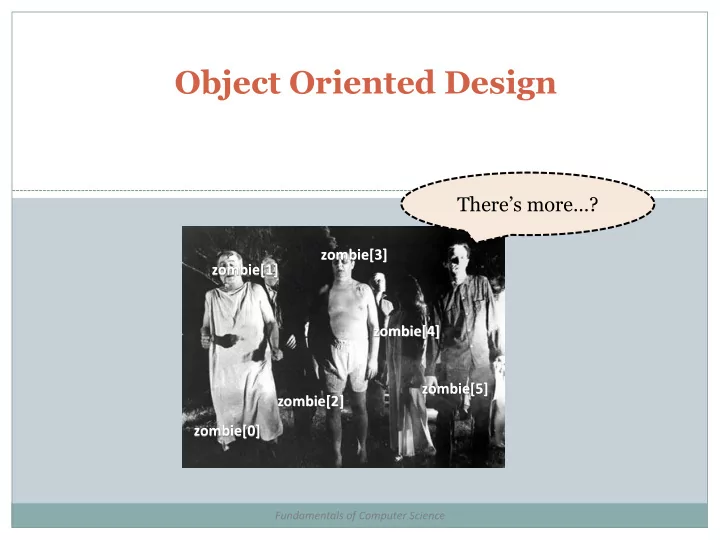

Object Oriented Design There’s more…? zombie[3] zombie[1] zombie[4] zombie[5] zombie[2] zombie[0] Fundamentals of Computer Science
Outline Object Oriented Design Identify the Classes Identify what Information each Class Needs Identify what each Class Needs to Do
Software Development Life Cycle 1. Understand the Problem = Requirements Analysis 2. Work out the Logic = Design 3. Convert it to Code = Implementation 4. Test/Debug 5. Maintenance Today we will talk about requirements analysis and object oriented design. 3
What are the Nouns? You have been hired to automate bank operations for a local credit union. They have told you that their business operates as follows: Customers can open accounts. They can make deposits and withdrawals and can close accounts also. On some accounts interest needs to be added, and sometimes fees are deducted. All employees can help customers with deposits and withdrawals. Only some employees are authorized to open and close accounts. 4
From Last Year…
UML Diagram Class Name Product Person -Name -Type -SSN -Interest Applied Attributes/State -Address -Fees -Phone -Name of Account -Email -Minimum Balance -Preferred method of contact -Overdraft Fee Methods/Behavior -Stipulations for Withdrawal -Max Amount -Num Withdrawals Allowed Interest -Balance -End8 -Rate Inheritance (is-a) -Calculation Method -Loan or Savings * Employee Customer -Date -Account -Open Accounts? -Debit Card -Num of Customers -Accounts LIst -Hours of Operation -Account Length (Time) -Time Active -Account Balances -End3 Account -End4 -End7 -Hire Date -Ranking -Balance -Position -Loan? -Transaction History 1 -Salary -Credit Score -End5 * 1 -Authorized Parties / Levels -Direct Deposit -Type (Person/Corp.) -Open/Closed -Password/PIN -Date Opened 1 -Bill Autopay? -Who Opened Fee -Acct Number -End6 -Type +Assign Acct Number() -Account -Amount * -Date Composition (has-a) 1 -End1 Transaction -Date * -Type (Auto/Cash/Check) -Amount -End2 -Account Deposit Withdrawal -Origin -Unauthorized Attempts -Approve or Not
Simplifying the Design – Classes and Attributes Look for repetition of data Try to have each piece of data in only one place Look for “modifiers” These might indicate the attribute should be in a different class e.g. Under Customer, we have “Account Length (Time)” and “Account Balance” Since they both reference account, they should probably be in the Account class Walk through each attribute and see if it makes sense Does it really applies to that class
Modified UML Person Product -End7 -Type -Name -SSN -Interest Applied -Address -Fees Interest 1 -End8 -Phone -Name of Account -Rate -Email -Minimum Balance -Calculation Method -Preferred method of contact -Overdraft Fee * -End5 -Stipulations for Withdrawal -Max Amount -Num Withdrawals Allowed 1 Fee -End6 -Type -Amount * Employee Customer -Open Accounts? -Num of Customers -Debit Card -Hours of Operation -Accounts List -Time Active -Ranking -End3 Account -End4 Removed account data -Hire Date -Loan? -Balance -Position -Credit Score Made interest and fees part of product -Transaction History 1 -Salary -Type (Person/Corp.) * -Authorized Parties / Levels -Direct Deposit -Password/PIN -Open/Closed -Bill Autopay? -Date Opened -Who Opened -Acct Number +Assign Acct Number() 1 -End1 Transaction -Date * -Type (Auto/Cash/Check) -Amount -Account -End2 -Origin -Approve or Not Removed deposit and withdrawal
Add Behaviors - What are the Verbs? You have been hired to automate bank operations for a local credit union. They have told you that their business operates as follows: Customers can open accounts. They can make deposits and withdrawals and can close accounts also. On some accounts interest needs to be added, and sometimes fees are deducted. All employees can help customers with deposits and withdrawals. Only some employees are authorized to open and close accounts. 9
UML with Behaviors Person Product -Name -Type -End7 -SSN -Interest Applied -Address -Fees -Phone -Name of Account 1 Interest -Minimum Balance -End8 -Email -Rate -Preferred method of contact -Overdraft Fee -Stipulations for Withdrawal -Calculation Method +Create() * -Max Amount +Read() -End5 -Num Withdrawals Allowed +Update() +Create() +Delete() +Read() 1 +Update() Fee -End6 +Delete() -Type -Amount * Employee Customer -Open Accounts? -Num of Customers -Debit Card Account -Hours of Operation -Accounts List -End4 -Balance -End3 -Time Active -Ranking -Transaction History -Hire Date -Loan? -Authorized Parties / Levels -Position -Credit Score * -Open/Closed 1 -Salary -Type (Person/Corp.) -Date Opened -Direct Deposit -Password/PIN -Who Opened -Bill Autopay? -Acct Number +Assign Customer ID() +Assign Acct Number() +Create() +Read() +Update() +Delete() Transaction 1 -End1 -Date -Type (Auto/Cash/Check) -Amount * -Account -Origin -Approve or Not -End2 +Create() +Read() +Update() +Delete()
More Design Use Cases Walk through typical uses of your software and make sure the state and behavior support those cases Application Program Interface – API Write an API for the interface to each of your classes For each method, define: Name Input Parameters Return Values Define data types for each attribute Might mean splitting a single attribute into several
Implementation Once we are happy with our class definitions, then we get to write some code!!
Summary Object Oriented Design Identify the classes Identify what information each class needs Identify what each class needs to do Identify use cases Define the API Define the instance variables Finally – write some code!
Recommend
More recommend